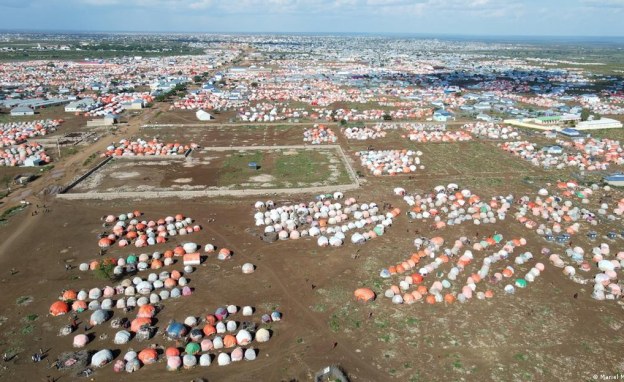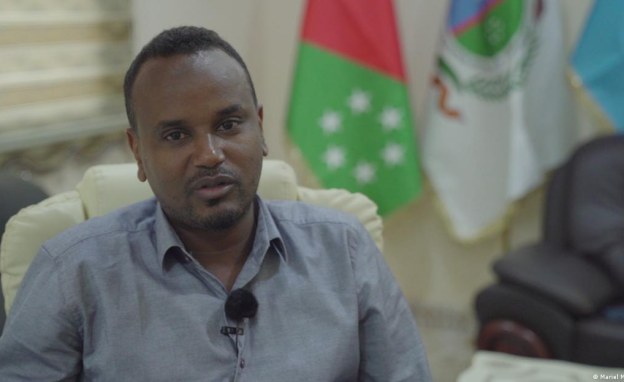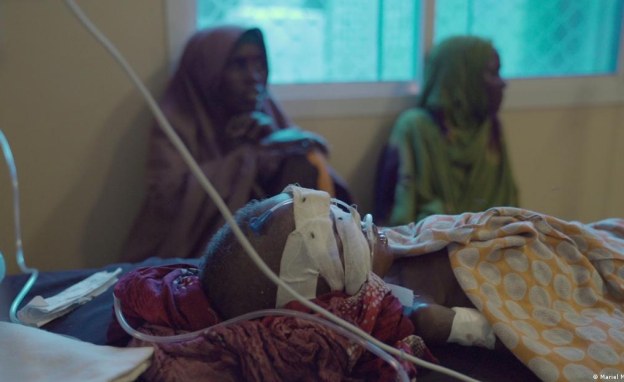Somalia’s food crisis is claiming young lives

By![]()
Oxygen machines beep and people whisper at the intensive care unit of Banadir Hospital in Mogadishu, Somalia’s capital. Foil shields the windows from sunlight and lets in a blue glow.
The worst cases of child malnutrition are refered to this facility. The doctors say that many children die on the way here.
Amina Abdi is fighting for her life. The 4-year-old has been in a coma for days. “Now she weighs only 7 kilograms. Normally she should weigh around 16kg,” says Dr. Aweis Olow Hassan, the head of the hospital’s pediatric department.
“She came with severe acute malnutrition, in a critical condition. We just call it ‘shock’. She’s a terminal case.”
UN: One case every minute at clinics
Amina’s mother and aunt have lost three children between them this year. The United Nations says a severely malnourished child is admitted to hospital every minute of every day on average.
The worst drought in 40 years is devastating Somalia. Fear that a fifth consecutive failed rainy season is upon the country is growing. More than 7 million people are in need of food assistance.
Amina’s family used to be livestock farmers. “We had farms and we had livestock, but we lost all of it because of the drought and thirst. We’ve been facing the drought for three years now. When it got worse, we left and we came to the city,” says her aunt, Arda Mohammed Osman.
Dr. Hassan explains that when a malnourished mother stops giving breastmilk, her infant can starve. The baby starts vomiting or having diarrhea and fever. Often the parents don’t know it’s starvation until it’s too late. “Cases are coming in a terminal state, so some of them may die whatever you do”.
Malnourished babies will likely have cognitive impairment growing up, says Dr. Hassan. “This malnourished child will not be a good leader. He won’t be a good president or MP because of malnutrition. What we worry about is not only his productivity and learning ability. We worry about their future leadership.”

Baidoa Mayor Abdullahi Ali Watiin is tired of short-sighted solutions.
Farmers face drought and extremists
At Banadir Hospital, one man is sitting with his two-month-old baby girl. The child is called Ruqiyo but he prefers not to see his own name published, the man says.
He used to be a farmer in the central Galguduud region. After al-Shabab took over his land, he fled. “They bother people a lot. They take your livestock and they want you to join them. They were telling us to join the fighting. And at the same time our livestock was perishing because of the drought.”
The al-Qaida-linked Islamist militant group controls vast parts of rural Somalia. Ruqiyo’s father says al-Shabab has ruled his village for 13 years now. His relatives say the situation is deteriorating by the day, with people starving and water in short supply.
“There is no aid. The government doesn’t go there and aid doesn’t go there. And they (al-Shabab) don’t help anyone,” he says.
1.6 million displaced this year alone
On October 29, al-Shabab carried out its deadliest attack in five years. Two car bombs exploded at a busy intersection in Mogadishu, killing more than 120 people. In 2017, an attack at the same junction claimed 500 lives.
Some 240 kilometres away in the Bay region, most of Somali’s 1.6 million newly displaced people have found shelter from the drought and conflict. They made their way to the regional capital Baidoa and the areas around to escape the drought and conflict, according to the UN.
Hundreds of improvised camps are spread around the city of 800,000 to accomodate almost the same amount of displaced people. Baidao Mayor Abdullahi Ali Watiin says the camps are expected to house up to 1 million people by the end of the year.
Child deaths have doubled in a year
Hawo Issack Moalim and her five children are staying in a tent at one of the camps in Baidoa. The 50-year-old says she left home after her camels died of thirst.
“We came here because of hunger, but until now we haven’t received any help. We barely receive water or food. We are really struggling here,” she says.
A few weeks ago, her son Hassan Issack fell ill with whooping cough, vomiting and diarrhea. The tablets he received at the camp did not help.

Amina Abidi’s mother and aunt have not left her side at Banadir Hospital.
“Because of the drought, he died. He’s been buried for 15 days now. He was eight years old.” Isaack Moalim says she has no time to grieve — she has to ensure that her other children survive.
The UN Children’s Fund (UNICEF) says that so far this year, 964 children died in Somalia, nearly twice as many as in 2021.
“We have half a million children that are severely acutely malnourished, which means that if they don’t receive assistance, timely, they are just simply going to die,” says Wafaa Saeed, the UNICEF representative for Somalia.
The UN has raised only half of the funds it needs to help, with $1 billion more needed to prevent a humanitarian catastrophe, she says.
Al-Shabab ‘one of the chronic diseases’
The government of Somalia has yet to declare a famine, even though some aid workers say the threshold for famine has already been reached in areas such as Baidoa.
A declaration of famine would unlock more aid into the country and save lives, non-governmental organizations say. But in a recent interview, President Hassan Sheikh Mohamud said even if more aid were to flow, al-Shabab would prevent it reaching those in need.
In 2011, most of the 260,000 deaths that occured as a result of famine in Somalia, were recorded before a famine was declared.
UN agencies have scaled up their efforts, according to the Somalia UNICEF representative Wafaa Saeed. “But this is not enough because this climate crisis is a protracted situation. We need to invest in prevention. We need to support these families in defence of their livelihoods.”
In 2011, large parts of the country, including Baidoa, were under al-Shabab control. In February 2012, the army drove the extremists out.
Mayor Watiin is on patrol with Police Station Commander Mohamed Nor Muktar. He says they are doing their best to keep al-Shabab out of Baidoa. But the extremists are stationed some 30km from the city borders.
“We’re on high alert day and night to avoid getting ambushed,” Nor Muktar says.
Police patrol daily while community and religious leaders and elders work to prevent al-Shabab from recruiting young men.
“Al-Shabab has become one of the chronic diseases that we have faced in the last 15 and more years,” says Watiin. “And people have suffered a lot in terms of the security, environment and economic crisis.”